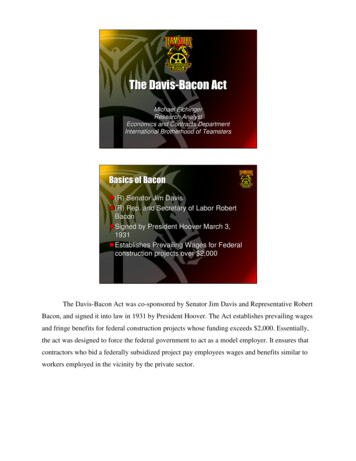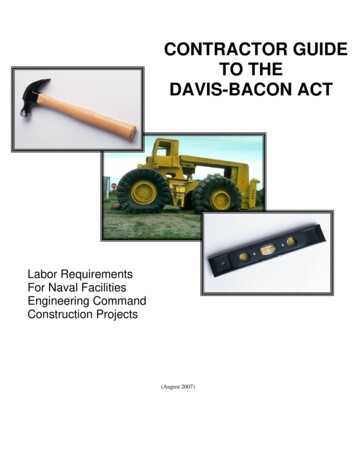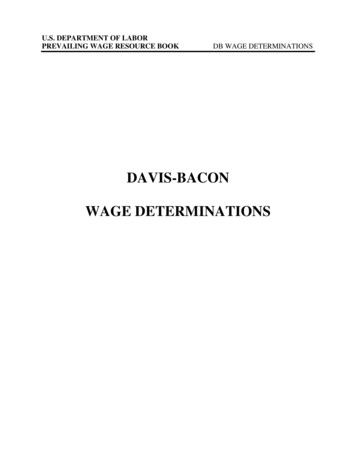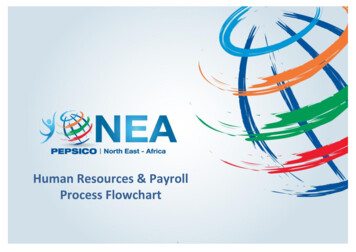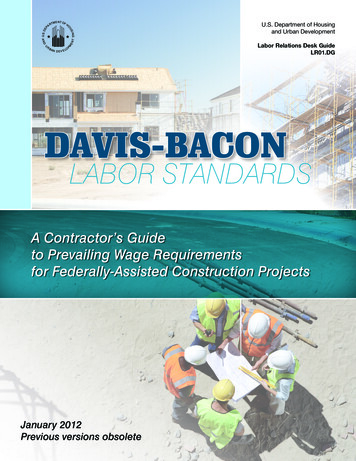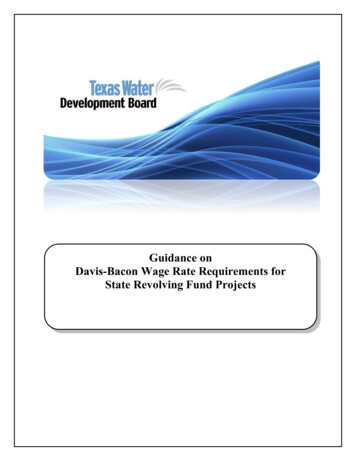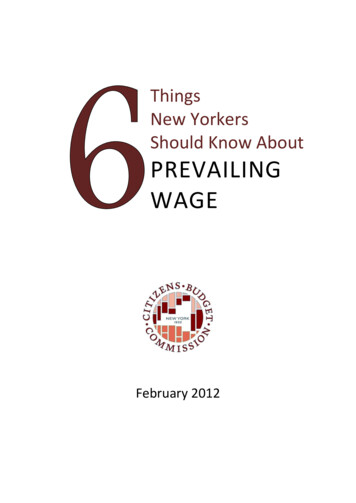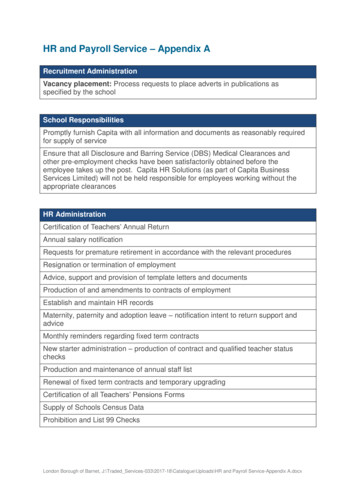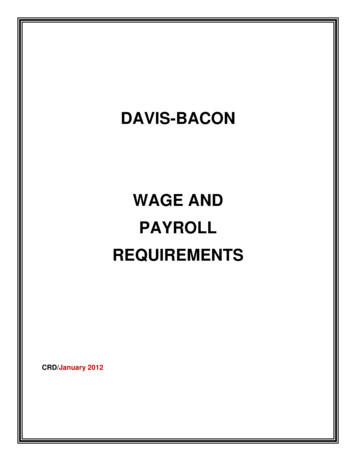
Transcription
DAVIS-BACONWAGE ANDPAYROLLREQUIREMENTSCRD/January 2012
DAVIS-BACON WAGE AND PAYROLLREQUIREMENTSJANUARY 2012Prepared byNORTH DAKOTA DEPARTMENT OF TRANSPORTATION608 EAST BOULEVARD AVENUEBISMARCK, NORTH DAKOTA 58505-0700www.dot.nd.govCIVIL RIGHTS DIVISIONE. Diane Laub, DirectorTelephone: 701-328-2576These guidelines are provided to assist contractors in complying with the federalwage and payroll requirements of the Davis-Bacon and Related Acts on NorthDakota Department of Transportation federally funded highway constructionprojects ONLY. Although the information contained in the handbook has beenobtained from reputable sources in accordance with currently availableinformation, it may not be applicable to other contracting agencies or other StateDepartments of Transportation. The Civil Rights Division provides technicalassistance to ONLY those contractors working on federally funded highwayconstruction projects in North Dakota.
TABLE OF CONTENTSA.Special Provisions. 1B.Site of the Work Definition . 2C.Application of DBRA to Truck Drivers . 9D.Payment of Predetermined Minimum Wage . 15E.Counting and Reporting Time . 17F.Overtime Hours . 20G.Fringe Benefit Payments. 23H.Payroll Deductions . 28I.Payroll Requirements. 31J.Classifications . 361.Carpentry. 362.Concrete Finishing . 383.Concrete Saw Operators . 444.Core Sampling . 445.Dowel Basket and Dowel Bar Placement . 446.Flaggers. 457.Joint Sealing . 458.Line Construction and Electricians . 469.Mechanics, Greasers, Oilers . 4710.Pipelayers . 4811.Rumble Strip Machine Operators . 4912.Truck Drivers. 4913.Water Spraying Equipment . 5314.Weed Sprayers . 5315.Welders. 54K.Exemptions from DBRA Coverage . 54L.Conformance Process . 60M.Child Labor Laws. 61N.Unclaimed Paychecks . 62O.Employees Hired Through Temporary Employment Agencies . 63P.Bulletin Boards . 64
Q.Labor Compliance Job-Site Interviews . 66R.NDDOT Civil Rights Division Personnel . 67S.Federal and State Department of Labor Personnel . 67EXHIBIT 1: INSTRUCTIONS AND LINKS TO PAYROLL FORMS . iINSTRUCTIONS FOR COMPLETING PAYROLL FORM (WH-347)AND STATEMENT OF COMPLIANCE . iPAYROLL - FORM WH-347 AND STATEMENT OF COMPLIANCE .viEXHIBIT 2: CONFORMANCE PROCESS . viiSAMPLE LETTER TO NDDOT .viiREQUESTS FOR ADDITIONAL CLASSIFICATIONS AND WAGE RATES .viiiREQUEST FOR AUTHORIZATION OF ADDITIONAL CLASSIFICATION AND RATE .ixCLASSIFICATION & WAGE RATE REQUEST - EMPLOYEE INFORMATION . xEXHIBIT 3: REQUIRED CONTRACT PROVISIONS, FEDERAL-AID CONSTRUCTIONCONTRACTS (USDOT FORM FHWA 1273) .xi
DAVIS-BACON WAGE AND PAYROLL REQUIREMENTSThe following is a summary of the wage and payroll requirements under the DavisBacon and Related Acts (DBRA):A.Special Provisions1.Under DBRA, all persons employed on or working upon the site of thework of a federally funded highway construction contract MUST be paid thewage rates and fringe benefits determined by the Secretary, U.S.Department of Labor (USDOL), to be prevailing in the area of the project.In addition, DBRA requires that certain labor standards provisions bespecified in the contract awarded to the successful bidder and that theapplicable Davis-Bacon wage rate decision also be included in thecontract documents. Consequently, all federally-aided highwayconstruction contracts contain the following special provisions:a.Required Contract Provisions, Federal-aid ConstructionContracts (U.S. Department of Transportation Form FHWA 1273 Rev. 3-94)*. This special provision outlines contractorrequirements relating to wages, payrolls, and compliancestatements and is available online m*The USDOL regulations concerning employees’ social securitynumbers and addresses on Davis-Bacon weekly certified payrollswere changed effective January 18, 2009. The U.S. Department ofTransportation (USDOT) Form FHWA 1273 has NOT, as yet, beenrevised to reflect the changes. Consequently, the North DakotaDepartment of Transportation (NDDOT) has modified the FHWA1273 to incorporate the changes. The NDDOT version (Rev.January 18, 2009) MUST be used until USDOT revises Form FHWA1273. The NDDOT version is available online pdfb.Labor Rates from U.S. Department of Labor. This special provisionspecifies basic hourly rates and applicable fringe benefit paymentsfor job classifications related to highway construction and isavailable online at (select a published date from the drop-downbox):DAVIS-BACON - January 2012Page 1
ce.htmB.2.Prime contractors are required to include these special provisions in allsubcontracts and to further require their inclusion in any lower-tiersubcontracts that may, in turn, be made. The prime contractor isresponsible for compliance by any subcontractor or lower-tiersubcontractor.3.Whenever any state, county, or city funded project is combined with or tiedto a federally funded project as one contract, the entire contract isconsidered federally funded and is subject to DBRA. Therefore, DavisBacon wages MUST be paid and weekly certified payrolls MUST begenerated and submitted for all portions or segments of the contract.Site of the Work Definition1.The definition for the site of the work has undergone many changes dueto challenges to USDOL's interpretation of DBRA. The courts havesignificantly narrowed the definition previously used. In January 2001,USDOL released the following new definition modifying 29 CFR 5.2(j)(l):“The site of the work definition includes material or supply sources, toolyards, job headquarters, etc., in the site of the work only where they arededicated to the covered construction project and are adjacent orvirtually adjacent to the location where the building or work is beingconstructed.”2.The new definition applies to all federal-aid projects let to contract (NOTawarded) after January 19, 2001.NOTE: Let to contract means the bid opening date.3.Also changed is:“The regulatory definition of construction to provide that the off-sitetransportation of materials, supplies, tools, etc., is not covered unlesssuch transportation occurs between the construction work site and adedicated facility located adjacent or virtually adjacent to theconstruction site.”4.The key is dedicated to the job site AND adjacent or virtually adjacent tothe location where the work is being constructed. NDDOT has definedadjacent or virtually adjacent as any tool yard, fabrication plant, jobheadquarters, material or supply source (i.e., borrow pit, stockpile site,DAVIS-BACON - January 2012Page 2
concrete or asphalt batch plant site), etc., whose boundary is locatedwithin one-half mile of the closest right of way boundary to the federalaid project. The distance is measured as one-half mile from the boundaryto the tool yard, fabrication plant, job headquarters, material orsupply source (i.e., borrow pit, stockpile site, concrete or asphalt batchplant site), etc., to the closest project boundary, as the crow flies, NOT tothe middle of the project.5.6.The federal regulations further define the site of the work as:a.“I(1) The site of the work is the physical place or places where thebuilding or work called for in the contract will remain; and any othersite where a significant portion of the building or work isconstructed, provided that such site is established specifically forthe performance of the contract or project.”b.“I(2) Except as provided in paragraph I(3) of this section, jobheadquarters, tool yards, batch plants, borrow pits, etc., are part ofthe site of the work provided they are dedicated exclusively, ornearly so, to performance of the contract or project, and providedthey are adjacent or virtually adjacent to the site of the work asdefined in paragraph I(1) of this section.”c.“I(3) Not included in the site of the work are permanent homeoffices, branch plant establishments, fabrication plants, tool yards,etc., of a contractor or subcontractor whose location andcontinuance in operation are determined wholly without regard to aparticular federal or federally assisted contract or project. Inaddition, fabrication plants, batch plants, borrow pits, jobheadquarters, tool yards, etc., of a commercial or material supplier,which are established by a supplier of materials for the projectbefore opening of bids and not on the site of work as stated inparagraph I(1) of this section, are not included in the site of thework. Such permanent, previously established facilities are notpart of the site of the work, even where the operations for a periodof time may be dedicated exclusively, or nearly so, to theperformance of the contract.”Supplying and Hauling Materiala.If the boundary to a borrow pit, stockpile site, concrete or asphaltbatch plant site, etc., is located more than one-half mile from theDAVIS-BACON - January 2012Page 3
closest right of way boundary to a federal-aid project, DBRAgenerally* DOES NOT apply. It DOES NOT matter when the projectwas let to contract (NOT awarded) because the borrow pit,stockpile site, concrete or asphalt batch plant site, etc., is morethan one-half mile away.b.If the boundary to a borrow pit, stockpile site, concrete or asphaltbatch plant site, etc., is located one-half mile or less from theclosest right of way boundary to a federal-aid project,(1)DBRA generally* DOES NOT apply if the borrow pit, stockpilesite, concrete or asphalt batch plant site, etc., HAS BEENopen and making sales to the general public within theprevious twelve months of the day the project was let tocontract (NOT awarded).(2)DBRA DOES apply if the borrow pit, stockpile site, concreteor asphalt batch plant site, etc., HAS NOT BEEN open andmaking sales to the general public within the previoustwelve months of the day the project was let to contract(NOT awarded).*If the time spent on the site of the work loading and/orunloading materials, supplies, tools, etc., is NOT more than deminimis (only a few minutes at a time merely to pick up or dropoff materials, supplies, tools, etc.). See Section C (page 9) forinformation concerning the application of DBRA to truckdrivers.c.Except as noted in Section C (page 9), the manufacture anddelivery to a federal-aid project of supply items such as sand,gravel, and ready-mix concrete, when accomplished by a bona fidematerial supplier operating facilities serving the public in general,are activities generally NOT covered by DBRA. This would be soeven though the materials are delivered directly into a contractor'smixing facilities at the work site. Such bona fide material suppliersare NOT considered contractors under DBRA. Thus, theiremployees are generally NOT due Davis-Bacon wages and weeklycertified payrolls are generally NOT required by NDDOT. Whatconstitutes a sufficient quantity of sales to the general publicdepends on the circumstances in each case, but MUST be morethan mere token sales.DAVIS-BACON - January 2012Page 4
d.The supplier MUST be able to demonstrate that he or she hasroutinely been selling to the general public from the borrow pit,stockpile site, concrete or asphalt batch plant site, etc., andthat the borrow pit, stockpile site, concrete or asphalt batchplant site, etc., was opened for that use, NOT for the federal-aidproject in question. In other words, if they are normally considereda supplier but they opened the borrow pit, stockpile site, concreteor asphalt batch plant site, etc., just for the federal-aid project,AND the borrow pit, stockpile site, concrete or asphalt batchplant site, etc., is located one-half mile or less from the closestright of way boundary to the project, they would be considered asubcontractor and NOT a supplier. Consequently, Davis-Baconwages would be due and weekly certified payrolls would berequired.e.If DBRA DOES apply to a borrow pit, stockpile site, concrete orasphalt batch plant site, etc., the employees who perform tasksdirectly related to producing the product are covered, including thetruck drivers who haul the materials from the borrow pit, stockpilesite, concrete or asphalt batch plant site, etc., to the federal-aidproject, regardless of on whose weekly certified payroll theyappear.f.It DOES NOT matter who owns the borrow pit, stockpile site, concreteor asphalt batch plant site, etc.; who is crushing; or who isproducing the product. What matters is whether the borrow pit,stockpile site, concrete or asphalt batch plant site, etc., isdedicated to the federal-aid project AND is adjacent or virtuallyadjacent to the project.g.In addition, it DOES NOT matter if the borrow pit is a state-optionedpit. If the borrow pit is located more than one-half mile from theclosest right of way boundary to the federal-aid project, DBRAgenerally* DOES NOT apply.h.If rubble or other material is hauled from a federal-aid project to alocation designated in the plans and specifications for the project,DBRA DOES apply and weekly certified payrolls are required. Ifno location is designated in the plans and specifications and thetruck drivers are hauling the rubble or material from the project to alocation determined to NOT be a site of the work, DBRADAVIS-BACON - January 2012Page 5
generally* DOES NOT apply and weekly certified payrolls aregenerally* NOT required by NDDOT.*If the time spent on the site of the work loading and/orunloading materials, supplies, tools, etc., is NOT more than deminimis (only a few minutes at a time merely to pick up or dropoff materials, supplies, tools, etc.). See Section C (page 9) forinformation concerning the application of DBRA to truckdrivers.i.However, if a material supplier, manufacturer, or carrierundertakes to perform a part of a federal-aid contract as asubcontractor, its laborers and mechanics (those who performmanual labor) employed at the site of the work would be subjectto DBRA in the same manner as those employed by any othersubcontractor and weekly certified payrolls would be required.In addition, employees of a material supplier who are required toperform more than an incidental amount of construction work inany given workweek at the site of the work of a federal-aidproject would be covered by DBRA and due the appropriatewage, including applicable fringe benefits, for the classificationof work performed. This includes warranty and/or repair work.(1)(2)DAVIS-BACON - January 2012For example:(a)If an employee of a supplier of precast concreteitems is required to go to the federal-aid project torepair and clean such items, and in so doingperforms more than an incidental amount ofconstruction activity on the project, the individualwould be subject to DBRA.(b)An employee of an equipment rental dealer or tirerepair company who performs on-site repair workon leased equipment is subject to DBRA if theemployee performs more than an incidentalamount of work on the federal-aid project.For enforcement purposes, if such an employee spendsmore than 20 percent of his or her time in a workweekengaged in such activities on the site of the work of afederal-aid project, he or she is DBRA covered for all timePage 6
spent on the site of the work during that workweek. Theemployee MUST be paid the appropriate Davis-Bacon wage,including applicable fringe benefits, for those hours andweekly certified payrolls MUST be generated and submitted.(3)j.However, this DOES NOT pertain to truck drivers whospend time on a federal-aid project or the site of thework of a federal-aid project merely to pick up or dropoff materials, supplies, tools, etc. They would besubject to the de minimis ruling. [See Section C (page9) for information concerning the application of DBRA totruck drivers.]Whenever any state, county, or city funded project is combined withor tied to a federally funded project as one contract, Davis-Baconwage rates MUST be paid and weekly certified payrolls MUST begenerated and submitted for all portions or segments of thecontract. Consequently, the principles previously described applyto borrow pits, stockpile sites, concrete or asphalt batch plant sites,etc., used for the contract or project. For example:(1)A contract has three portions or segments, of which two arefederally funded and one is strictly state funded.(2)There is a two and one-half mile gap between the statefunded portion or segment and the next closest federallyfunded portion or segment.(3)Material is being hauled from a borrow pit located less thanone-half mile from the closest right of way boundary to thestate funded portion or segment.(a)Because two of the portions or segments are federallyfunded, the entire project is viewed as federallyfunded.(b)Since the borrow pit is located less than one-halfmile from the closest right of way boundary to thestate funded portion or segment; DAVIS-BACON - January 2012DBRA generally* DOES NOT apply if the borrow pitHAS BEEN open and making sales to the generalPage 7
public within the previous twelve months of theday the project was let to contract (NOTawarded). DBRA DOES apply if the borrow pit HAS NOT BEENopen and making sales to the general public withinthe previous twelve months of the day the projectwas let to contract (NOT awarded).*If the time spent on the site of the work loading and/orunloading materials, supplies, tools, etc., is NOT morethan de minimis (only a few minutes at a time merely topick up or drop off materials, supplies, tools, etc.). SeeSection C (page 9) for information concerning theapplication of DBRA to truck drivers.k.(4)DBRA applies to anyone working adjacent (within one-halfmile) to the boundaries of the project site, normally at aborrow pit, stockpile site, concrete or asphalt batch plantsite, etc.(5)If material is hauled from that same borrow pit to any one ofthe other two portions or segments, which are NOT adjacentto the borrow pit, DBRA still applies because the portions orsegments are looked at as a whole.There are times when, at the end of a federal-aid project, NDDOTadds another mile or two to the project through the issuance of achange order. If it was previously determined that the boundary toa borrow pit, stockpile site, concrete or asphalt batch plant site,etc., was located more than one-half mile from the closest right ofway boundary to the project but the added segment brings theboundary to the borrow pit, stockpile site, concrete or asphalt batchplant site, etc., within one-half mile of the project boundary:(1)Those employees working on the additional segment underthe change order would be due Davis-Bacon wages,including applicable fringe benefits, and weekly certifiedpayrolls would be required.(2)Those employees hauling from and working at the borrowpit, stockpile site, concrete or asphalt batch plant site, etc.,DAVIS-BACON - January 2012Page 8
under the change order would be due Davis-Bacon wages,including applicable fringe benefits, and weekly certifiedpayrolls would be required by NDDOT ONLY if the borrow pit,stockpile site, concrete or asphalt batch plant site, etc., WASNOT open and making sales to the general public within theprevious twelve months of the day the project was let tocontract (NOT awarded) and ONLY if the truck drivers' timespent on the additional segment under the change orderis more than de minimis. [See Section C (page 9) forinformation concerning the application of DBRA to truckdrivers.]l.C.If it is unclear whether a borrow pit, stockpile site, concrete orasphalt batch plant site, etc., is considered a site of the work of afederal-aid project, contact the NDDOT Civil Rights Division for aruling. [See Section R (page 67) for addresses and phonenumbers.]Application of DBRA to Truck DriversThe application of DBRA to truck drivers is based on the definition ofconstruction, prosecution, completion, or repair in 29 CFR 5.2(1). ThreeU.S. appellate court decisions in the 1990's helped to clarify thesedefinitions and provide the guidelines below (65 FR 80268-80278,December 20, 2000):1.Truck drivers ARE COVERED under DBRA in the followingcircumstances:a.Truck drivers of a prime contractor or subcontractor for timespent working on the site of the work.(1)DAVIS-BACON - January 2012In this instance, the site of the work means a federal-aidproject and any tool yard, fabrication plant, jobheadquarters, material or supply source (i.e., borrow pit,stockpile site, concrete or asphalt batch plant site), etc.,that is:(a)Dedicated to the federal-aid project AND(b)Adjacent or virtually adjacent to the federal-aidproject.Page 9
(2)NDDOT has defined adjacent or virtually adjacent as anytool yard, fabrication plant, job headquarters, material orsupply source (i.e., borrow pit, stockpile site, concreteor asphalt batch plant site), etc., whose boundary islocated within one-half mile of the closest right of wayboundary to a federal-aid project. The distance ismeasured as one-half mile from the boundary to the toolyard, fabrication plant, job headquarters, material orsupply source (i.e., borrow pit, stockpile site, concreteor asphalt batch plant site), etc., to the closest projectboundary, as the crow flies, NOT to the middle of theproject.(3)Dedicated to the federal-aid project means the borrowpit, stockpile site, concrete or asphalt batch plant site,etc., was NOT open and making sales to the generalpublic within the previous twelve months of the day theproject was let to contract (NOT awarded).NOTE: Let to contract means the bid opening date.b.Truck drivers of a prime contractor or subcontractor for timespent loading and/or unloading materials, supplies, tools, etc.,(including waiting time) on the site of the work, if such time isNOT de minimis.(1)In this instance, the materials, supplies, tools, etc.,would be coming from a location NOT covered by DBRAto a federal-aid project or the site of the work of afederal-aid project or going from a federal-aid project orthe site of the work of a federal-aid project to a locationNOT covered by DBRA (based on paragraph 1,a of thissection) and NOT designated in the plans andspecifications for the project (i.e., off-site).(2)De minimis, as defined by USDOL, means only a fewminutes at a time merely to pick up or drop off materials,supplies, tools, etc. According to USDOL:(a)DAVIS-BACON - January 2012The de minimis ruling is a result of the Midwaycourt case. The Midway truck drivers came onsite for only ten minutes at a time to drop off theirPage 10
deliveries and that the time spent directly uponthe site of the work constituted only ten percentof their workday; but no one argued in the casethat the truck drivers were covered only duringthat brief time. USDOL DOES NOT precludecoverage for time spent on the site of the work nomatter how brief. However, as a practical matter,since generally the great bulk of the time spent bymaterial truck drivers is off-site and beyond thescope of DBRA coverage while the time spent onsite is relatively brief, USDOL chooses to use arule of reason and will NOT apply DBRA withrespect to the amount of time spent on-site,unless it is more than de minimis.(b)In other instances, more than a substantialamount of time was previously defined as 20percent or more in a given workweek forenforcement purposes. However, this DOES NOTapply to truck drivers who spend time on afederal-aid project or the site of the work of afederal-aid project merely to pick up or drop offmaterials, supplies, tools, etc. There is NO setpercentage of time used to determine de minimis.USDOL will consider 5-10 percent to be deminimis but may NOT consider 18 percent or moreto be de minimis. Decisions on anything close to20 percent are made on a case-by-case basis.(c)Situations involving de minimis rulings normallyarise when: DAVIS-BACON - January 2012A borrow pit, stockpile site, concrete orasphalt batch plant site, etc., is located beyondthe half-mile limit but still close enough tocause the truck drivers less time in travel andmore time on the federal-aid project or the siteof the work waiting to be loaded and/orunloaded.Page 11
(d)A borrow pit, stockpile site, concrete orasphalt batch plant site, etc., is located withinthe half-mile limit and was open and makingsales to the general public within the previoustwelve months of the day the project was let tocontract (NOT awarded), thus making it acommercial borrow pit, stockpile site, concreteor asphalt batch plant site, etc., and thuscausing the truck drivers less time in traveland more time on the federal-aid project or thesite of the work waiting to be loaded and/orunloaded.The prime contractor is ultimately responsible forcompliance by it and any of its subcontractorsand material suppliers. The burden of proof lieswith the prime contractor and its subcontractorsand material suppliers. The prime contractor andits subcontractors and material suppliers caneither: Pay the appropriate Davis-Bacon wage,including applicable fringe benefits, for all ofthe hours the truck drivers spend on thefederal-aid project or the site of the work; or Keep accurate records of the time so spent onthe federal-aid project or the site of the workand pay the appropriate Davis-Bacon wage,including applicable fringe benefits, for thetime spent on-site that is more than deminimis.NOTE: The prime contractor can either includethe truck drivers on its weekly certified payrolls orrequire the subcontractor or material supplier togenerate and submit weekly certified payrolls forthe time spent on-site that is more than deminimis.(e)DAVIS-BACON - January 2012In determining whether a truck driver's time spenton-site is more than de minimis, USDOLPage 12
recommends basing the percent of time spent onsite on all of the hours the truck driver works inany given workweek rather than the truck driver'sdaily hours. Thus, 8 hours out of a 40-hourworkweek would be 20 percent.c.(f)A prime contractor's, subcontractor's, or materialsupplier's failure to keep accurate records maycause NDDOT to side with the complainant shoulda wage dispute ensue.(g)If a wage dispute does ensue and it is determinedthat a subcontractor's or material supplier's truckdrivers spent more than a de minimis amount oftime on a federal-aid project or the site of thework of a federal-aid project, and it is found thatthe prime contractor did NOT incorporate the laborstandards provisions and/or Davis-Bacon wagerate decision into the subcontract or purchaseagreement, the prime contractor will be held liablefor any back wages found due.(h)The prime contractor can minimize the likelihoodof situations occurring where de minimis rulingsare required by having truck drivers wait atlocations considered NOT to be a site of the workuntil radioed in.Tr
DAVIS-BACON - January 2012 Page 3 concrete or asphalt batch plant site), etc., whose boundary is located within one-half mile of the closest right of way boundary to the federal-aid project. The distance is measured as one-half mile from the boundary to the tool yard, fabrication plant, job headquarters, material or
